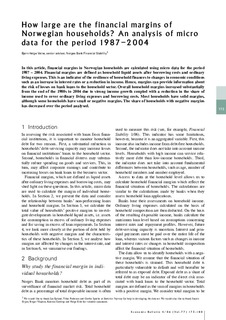| dc.contributor.author | Vatne, Bjørn Helge | |
| dc.date.accessioned | 2018-07-04T10:17:59Z | |
| dc.date.available | 2018-07-04T10:17:59Z | |
| dc.date.issued | 2006 | |
| dc.identifier.issn | 0029-1676 | |
| dc.identifier.issn | 1503-8831 | |
| dc.identifier.uri | http://hdl.handle.net/11250/2504289 | |
| dc.description.abstract | In this article, financial margins in Norwegian households are calculated using micro data for the period 1987 – 2004. Financial margins are defined as household liquid assets after borrowing costs and ordinary living expenses. This is an indicator of the resilience of household finances to changes in economic conditions such as an increase in interest rates or a reduction in income. Hence, margins can provide information about the risk of losses on bank loans to the household sector. Overall household margins increased substantially from the end of the 1980s to 2004 due to strong income growth coupled with a reduction in the share of income used to cover ordinary living expenses and borrowing costs. Most households have solid margins, although some households have small or negative margins. The share of households with negative margins has decreased over the period analysed. | nb_NO |
| dc.language.iso | eng | nb_NO |
| dc.publisher | Norges Bank | nb_NO |
| dc.rights | Attribution-NonCommercial-NoDerivatives 4.0 Internasjonal | * |
| dc.rights.uri | http://creativecommons.org/licenses/by-nc-nd/4.0/deed.no | * |
| dc.title | How Large Are the Financial Margins of Norwegian Households? an Analysis of Micro Data for the Period 1987–2004 | nb_NO |
| dc.type | Journal article | nb_NO |
| dc.subject.nsi | VDP::Samfunnsvitenskap: 200::Økonomi: 210::Samfunnsøkonomi: 212 | nb_NO |
| dc.source.pagenumber | 173-180 | nb_NO |
| dc.source.journal | Economic Bulletin | nb_NO |
| dc.source.issue | 4/2006 | nb_NO |

